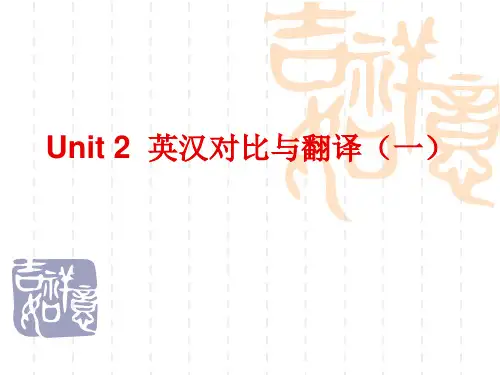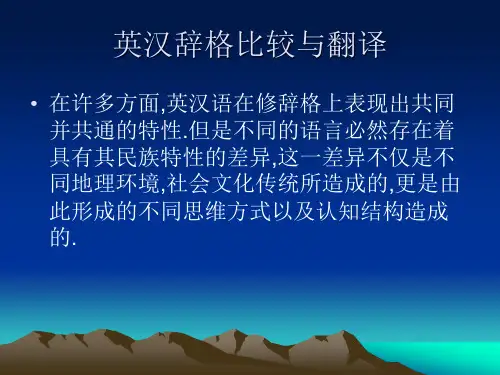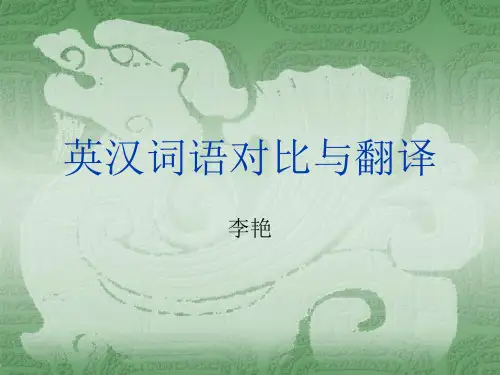英汉词格对比翻译
- 格式:ppt
- 大小:107.50 KB
- 文档页数:19
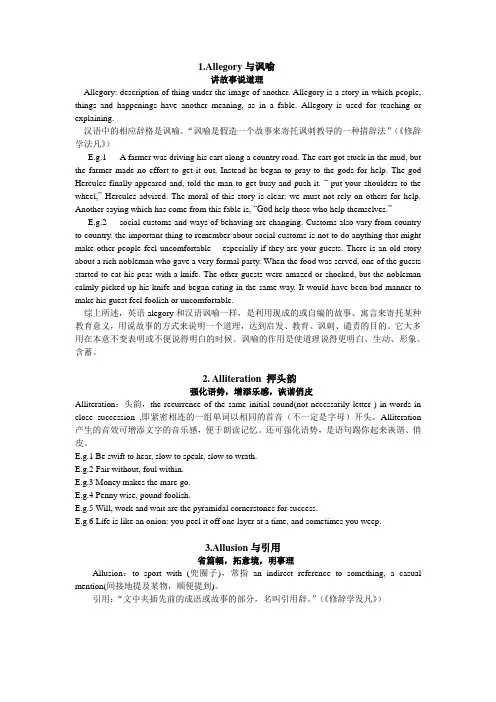
1.Allegory与讽喻讲故事说道理Allegory: description of thing under the image of another. Allegory is a story in which people, things and happenings have another meaning, as in a fable. Allegory is used for teaching or explaining.汉语中的相应辞格是讽喻。
“讽喻是假造一个故事来寄托讽刺教导的一种措辞法”(《修辞学法凡》)E.g.1 A farmer was driving his cart along a country road. The cart got stuck in the mud, but the farmer made no effort to get it out. Instead he began to pray to the gods for help. The god Hercules finally appeared and, told the man to get busy and push it. “ put your shoulders to the wheel,” Hercules advised. The moral of this story is clear: we must not rely on others for help. Another saying which has come from this fable is, “God help those who help themselves.”E.g.2 social customs and ways of behaving are changing. Customs also vary from country to country. the important thing to remember about social customs is not to do anything that might make other people feel uncomfortable----especially if they are your guests. There is an old story about a rich nobleman who gave a very formal party. When the food was served, one of the guests started to eat his peas with a knife. The other guests were amazed or shocked, but the nobleman calmly picked up his knife and began eating in the same way. It would have been bad manner to make his guest feel foolish or uncomfortable.综上所述,英语alegory和汉语讽喻一样,是利用现成的或自编的故事、寓言来寄托某种教育意义,用说故事的方式来说明一个道理,达到启发、教育、讽刺、谴责的目的。


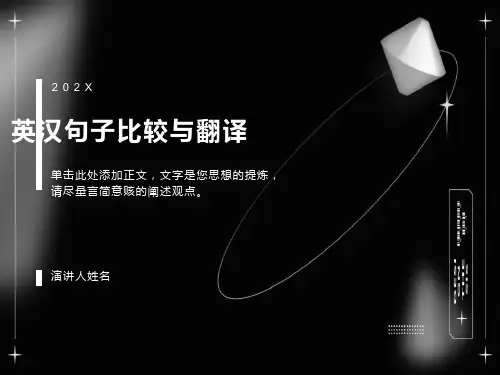

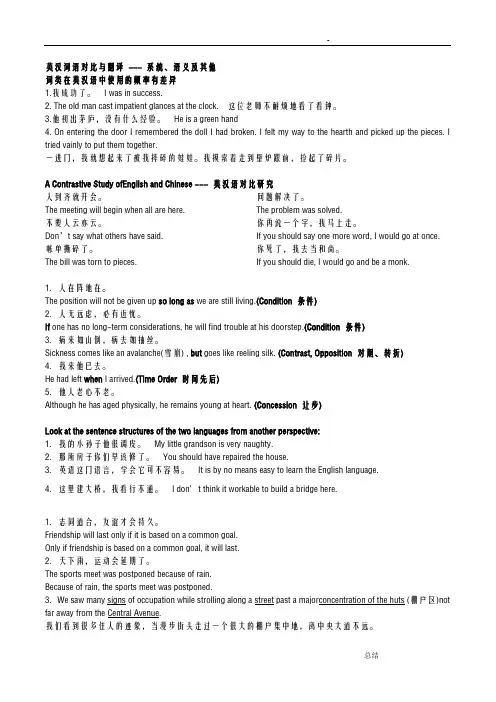
英汉词语对比与翻译--- 系统、语义及其他词类在英汉语中使用的频率有差异1.我成功了。
I was in success.2. The old man cast impatient glances at the clock. 这位老师不耐烦地看了看钟。
3.他初出茅庐,没有什么经验。
He is a green hand4. On entering the door I remembered the doll I had broken. I felt my way to the hearth and picked up the pieces. I tried vainly to put them together.一进门,我就想起来了被我摔碎的娃娃。
我摸索着走到壁炉跟前,捡起了碎片。
A Contrastive Study ofEnglish and Chinese --- 英汉语对比研究人到齐就开会。
The meeting will begin when all are here. 不要人云亦云。
Don’t say what others have said.帐单撕碎了。
The bill was torn to pieces. 问题解决了。
The problem was solved.你再说一个字,我马上走。
If you should say one more word, I would go at once. 你死了,我去当和尚。
If you should die, I would go and be a monk.1.人在阵地在。
The position will not be given up so long as we are still living.(Condition 条件)2.人无远虑,必有近忧。
If one has no long-term considerations, he will find trouble at his doorstep.(Condition 条件)3.病来如山倒,病去如抽丝。
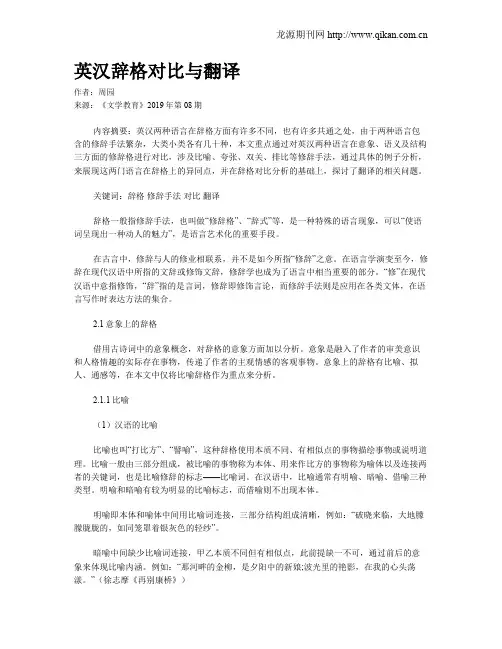
英汉辞格对比与翻译作者:周园来源:《文学教育》2019年第08期内容摘要:英汉两种语言在辞格方面有许多不同,也有许多共通之处,由于两种语言包含的修辞手法繁杂,大类小类各有几十种,本文重点通过对英汉两种语言在意象、语义及结构三方面的修辞格进行对比,涉及比喻、夸张、双关、排比等修辞手法,通过具体的例子分析,来展现这两门语言在辞格上的异同点,并在辞格对比分析的基础上,探讨了翻译的相关问题。
关键词:辞格修辞手法对比翻译辞格一般指修辞手法,也叫做“修辞格”、“辞式”等,是一种特殊的语言现象,可以“使语词呈现出一种动人的魅力”,是语言艺术化的重要手段。
在古言中,修辞与人的修业相联系,并不是如今所指“修辞”之意。
在语言学演变至今,修辞在现代汉语中所指的文辞或修饰文辞,修辞学也成为了语言中相当重要的部分。
“修”在现代汉语中意指修饰,“辞”指的是言词,修辞即修饰言论,而修辞手法则是应用在各类文体,在语言写作时表达方法的集合。
2.1意象上的辞格借用古诗词中的意象概念,对辞格的意象方面加以分析。
意象是融入了作者的审美意识和人格情趣的实际存在事物,传递了作者的主观情感的客观事物。
意象上的辞格有比喻、拟人、通感等,在本文中仅将比喻辞格作为重点来分析。
2.1.1比喻(1)汉语的比喻比喻也叫“打比方”、“譬喻”,这种辞格使用本质不同、有相似点的事物描绘事物或说明道理。
比喻一般由三部分组成,被比喻的事物称为本体、用来作比方的事物称为喻体以及连接两者的关键词,也是比喻修辞的标志——比喻词。
在汉语中,比喻通常有明喻、暗喻、借喻三种类型。
明喻和暗喻有较为明显的比喻标志,而借喻则不出现本体。
明喻即本体和喻体中间用比喻词连接,三部分结构组成清晰,例如:“破晓来临,大地朦朦胧胧的,如同笼罩着银灰色的轻纱”。
暗喻中间缺少比喻词连接,甲乙本质不同但有相似点,此前提缺一不可,通过前后的意象来体现比喻内涵。
例如:“那河畔的金柳,是夕阳中的新娘;波光里的艳影,在我的心头荡漾。

